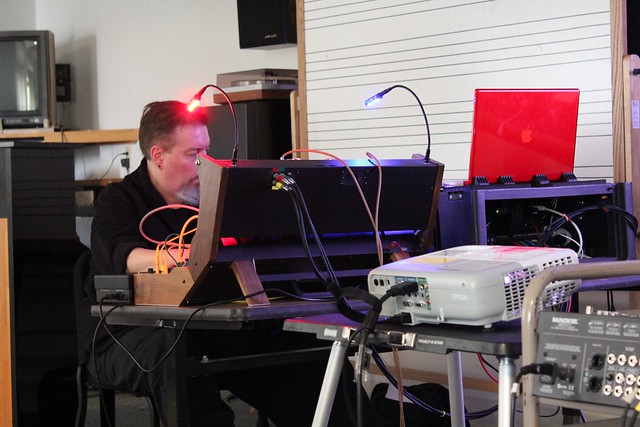
Hefix93 of
Velvet Acid Christ sent the following review of his new Eurorack format modular synth featuring
Doepfer,
Plan b,
Livewire and a
Kenton Pro Solo for MIDI to CV. You will find samples at the end of the review.
"
Kenton pro solo: Amazing midi to cv converter, its tight, real tight with logic sending it midi. i like the portamento and other things i can get out of it.. very good, worth every peny, also can do extra cv modulations with the aux out jack.
Plan b model 15 osc: The saw wav on this is simply mystifying. huh? i mean it is the meanest saw i have ever messed with. PWM is not so great, no attenuator and there is only active pulse on the pwm knob from 10 o'clock to 2 o'clock (don't know if this is standard on all modulars, as this is my first) this really irritates me [
Update: this is addressed at the end of this review by Peter Grenader of Plan b]. I got neat fm sounds, and sync. the sine is pretty cool. The small frequency knob really kinda irks me, its so hard to dial in any kind of tuning, which makes this a real bummer for live use. I hope i can get the pwm to work how i want in the future, if so, this osc will probably me favorite of all time. Seriously rips. This thing is so mean. I want to have him build me a custom osc based on this model 15 with all the things i want. i hope he will. I want a osc octave switch, pwm attenuator and a bigger freq knob that isn't so overly sensitive and hard to tune (granted, these are the first modular oscillators i have used so). I seriously love this osc.
doepfer a-118 Noise/random: wow, i love the colored noise on this module. and the random voltage thing is kinda neat as a modulator on my filter and other things. nice.
doepfer a-138 mixer: Wow this sounds decent. if you over drive this past 7, it gets pretty aggressive, great for the kind of music i do. nice..
doepfer a-131 VCA: Again decent sounding, and man if you go past 7, it gets real mean. i love it..
doepfer a-143 quad lfo: nice to have 4 lfos, i like the speed switch, this goes real slow and nice and fast. i love it. better than most synth lfos i've had. Can go real fast in the high mode, fm audio. nice...
doepfer a-125: this is the best phaser i've ever had, and i haven't had many, makes the phaser in the virus ti sound like a toy..can sound real thick and heavy, very psychedelic. wow. this will make my psy trance tracks kick major butt..
doepfer a-188-1 1024 bbd: Very cool short delay that does chorus and flange ok, not the best i've heard, the modcan sounds the best so far. but for strange detuned rubber band delay modulation sci fi weird stuff, this thing really rocks, but it makes me wish i had room for the 188-2 instead.. hrmm... still really good for the money.
doepfer a-140 adsr: Very snappy. i mean this thing handled my 160 bpm bass duties at 16th notes very well. better than most stuff i have owned. i have not tried to make kick drums yet or other percussion, so i don't know how well it does there. but for bass and leas, out standing fast poppy envs. i have not messed with the other speed settings other than the m. and that suits my needs so far. i got two of these. and man, i'm loving it.... so fast tho, they can pop, you have to mess with the attack and release a tad, but man. it snaps..
doepfer 1-180 multiples: what can i say, they split the multiply a signal by 3. awesome. does its job well. i get 1 in and 3 out x2 per module, i got 2 of these..
Livewire Frequensteiner multimode filter: i saved the best for last. what can i say, this thing is aggressive, and man, it is simply the best multimode filter i have ever owned. The low pass is very aggressive, as is the bandpass, and the highpass, but man, the high pass is the best on this filter. it hisses and bites and cuts in a mix so well, i cannot explain how much i love it. But honestly i really like all the filter modes a lot. if i push the audio input past 7 or 8, it over drives and gets really mean, i mean super pissed. AMAZING. This thing is worth every penny, i love the knobs, and the nice big frequency knob is much loved here. What other multimode filters have i owned? nordlead, jp8080, virus up to the ti, the jupiter 6, the andromeda. This thing is sick, i mean so great, i cannot rave bout it enough. This is now my favorite synth filter ever. Even beating out my love for the minimoog and jupiter 8 filters.. i'm just into that aggressive exciting sound this thing gives me.
I sold my roland jupiter 8 for this [
posted here]: i am not looking back, i love that old vintage lush instruments. but i needed something with more balls and bite and aggression, i got it. What i am able to pull of with this is amazing seriously mean bass and leads, that cut on all frequencies of the spectrum. And all the strange ufo sci blips and beeps that modulars are know for as well. This doesn't sound vintage, it has its own new sound, its stable and alive, but very precise and tight. zippy, and responsive. so much more so than i am used to. the modulations in the andromeda were sluggish and oogy, this is lightning fast and responsive, just how i like it. I am so glad that i took this big step. Sure i have some issues with the implementations on the the plan b model 15 with its pwm strangeness, but other than that, i love it all. I took back my virus ti and vsynths because they just didn't cut into my analog drum machine and monosynth dominated mixes. This thing does. it can get in there with my sh2, and future retro revolution just fine. as to where my virus would sound all faint and wouldn't cut, even with the high pass, it would kinda get lost and not stand out. that is not a problem here with this system. This is why i love analog so much more in the kind of music i make, i need stuff that has presence in the mix. digital doesnt. ANALOG DOES!
Sure after it was all said and done, it cost me about $2750. I bought it all from
Analogue Haven .. please if you do buy stuff because of these sound demos, tell them that you heard the clips from velvet acid christ and read this review. I want a hook up for getting him business. I'm addicted to this modular stuff, and i need all the help i can get now.. :) Shawn really is the one who help me build this system. He and i go way back. I'm so glad his store exists now. really helped me out here. i've been lusting after a fat system with a multimode filter for years. I FINALLY HAVE FOUND IT.. i'm so happy..
Oh and by the way, i made a bunch of quick sound demos of the this system doing the typical vac arp lines and basses. Feel free to check em out. I hope this gets you interested in modulars.. They are not just for strange blips and beeps, they can be great musical instruments as well. not just for the weird sci fi. take care.
bryan aka hexfix93 aka phuckhead aka disease factory....."
Samples:
http://www.velvetacidchrist.com/synth/model15frequensteinera-125vcp.mp3http://www.velvetacidchrist.com/synth/model15frequensteiner2lp125vcp1881bbd.mp3http://www.velvetacidchrist.com/synth/model15frequensteinerlp3.mp3http://www.velvetacidchrist.com/synth/model15frequensteinerlp4.mp3http://www.velvetacidchrist.com/synth/model15frequensteinerlp5.mp3http://www.velvetacidchrist.com/synth/model15frequensteinerbp6.mp3http://www.velvetacidchrist.com/synth/model15frequensteinerhp7.mp3Update via Peter Grenader of Plan b regarding PWM on the Plan b Model 15:"Morning...
The PWM construction is designed that way so that there are more possibilities for the VC input. I played around with this a lot while cooking the VCO, you're going to get some very interesting sounds when the manual offset is positioned to either the far left or right (either into the 'silent' zone) and a VC is applied to pull it back into audio that aren't availible otherwise. My PWM sound is unique, I wanted to keep it that way.
I think there is a misconception that by only having the square audible from 10 to 2 that you're loosing something. You're not - it's all there, it sweeps from full neg, through 0 to 100 duty cycle, then back from 100 to 0 to full positive. it just transverses that from the 10 o' clock pot setting to the 2 o clock pot setting. the balance of the pot regions, when the signal is zero is not wasted, it's there for VC possibilities.
If you own one of these, try it, you'll see what I'm speaking about. Move the pot to silence, apply and VC, then move the pot to so that the square isn't silent and apply the same VC. I didn't want to loose both effects.
hope this helps,
- P "



























































